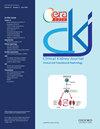Multiomic profiling of new-onset kidney function decline: insights from the STANISLAS study cohort with a 20-year follow-up
IF 3.9
2区 医学
Q1 UROLOGY & NEPHROLOGY
引用次数: 0
Abstract
Background Identifying the biomarkers associated with new-onset glomerular filtration rate (GFR) decrease in an initially healthy population could offer a better understanding of kidney function decline and help improving the patients’ management. Methods Here we described the proteomic and transcriptomic footprints associated with new-onset kidney function decline in an initially healthy and well-characterized population with a 20-year follow-up. This study was based on 1087 individuals from the familial longitudinal STANISLAS cohort who attended both visit 1 (from 1993 to 1995) and visit 4 (from 2011 to 2016). New-onset kidney function decline was approached both in quantitative (GFR slope for each individual) and qualitative (defined as a decrease in GFR of more than 15 mL/min/1.7m2) ways. We analyzed associations of 445 proteins measured both at visit 1 and visit 4 using Olink Proseek® panels and 119 765 genes expressions measured at visit 4 with GFR decline. Associations were assessed using multivariable models. Bonferroni correction was applied. Results We found several proteins (including PLC, PGF, members of the tumor necrosis factor receptor superfamily), genes (including CCL18, SESN3) and a newly discovered miRNA—mRNA pair (MIR1205–DNAJC6) to be independently associated with new-onset kidney function decline. Complex network analysis highlighted both extracellular matrix and cardiovascular remodeling (since visit 1) as well as inflammation (at visit 4) as key features of early GFR decrease. Conclusions These findings lay the foundation to further assess whether the proteins and genes herein identified may represent potential biomarkers or therapeutic targets to prevent renal function impairment.新发肾功能衰退的多组学特征:STANISLAS 研究队列 20 年随访的启示
背景 在最初健康的人群中确定与新发肾小球滤过率(GFR)下降相关的生物标志物,可以更好地了解肾功能衰退,有助于改善患者的管理。方法 在这里,我们描述了在一个最初健康、特征良好、随访 20 年的人群中与新发肾功能衰退相关的蛋白质组和转录组足迹。这项研究基于家族纵向 STANISLAS 队列中的 1087 人,他们参加了第 1 次就诊(1993 年至 1995 年)和第 4 次就诊(2011 年至 2016 年)。我们通过定量(每个人的 GFR 斜率)和定性(定义为 GFR 下降超过 15 mL/min/1.7m2)的方式来研究新发肾功能衰退。我们分析了在第 1 次和第 4 次就诊时使用 Olink Proseek® 面板测量的 445 种蛋白质以及在第 4 次就诊时测量的 119 765 个基因表达与 GFR 下降的相关性。使用多变量模型对相关性进行了评估。采用 Bonferroni 校正。结果 我们发现一些蛋白质(包括 PLC、PGF、肿瘤坏死因子受体超家族成员)、基因(包括 CCL18、SESN3)和新发现的 miRNA-mRNA 对(MIR1205-DNAJC6)与新发肾功能衰退有独立关联。复杂网络分析强调了细胞外基质和心血管重塑(自第 1 次就诊起)以及炎症(第 4 次就诊时)是早期 GFR 下降的关键特征。结论 这些发现为进一步评估本文所确定的蛋白质和基因是否可能成为预防肾功能损害的潜在生物标志物或治疗靶点奠定了基础。
本文章由计算机程序翻译,如有差异,请以英文原文为准。
求助全文
约1分钟内获得全文
求助全文
来源期刊

Clinical Kidney Journal
Medicine-Transplantation
CiteScore
6.70
自引率
10.90%
发文量
242
审稿时长
8 weeks
期刊介绍:
About the Journal
Clinical Kidney Journal: Clinical and Translational Nephrology (ckj), an official journal of the ERA-EDTA (European Renal Association-European Dialysis and Transplant Association), is a fully open access, online only journal publishing bimonthly. The journal is an essential educational and training resource integrating clinical, translational and educational research into clinical practice. ckj aims to contribute to a translational research culture among nephrologists and kidney pathologists that helps close the gap between basic researchers and practicing clinicians and promote sorely needed innovation in the Nephrology field. All research articles in this journal have undergone peer review.
 求助内容:
求助内容: 应助结果提醒方式:
应助结果提醒方式:


